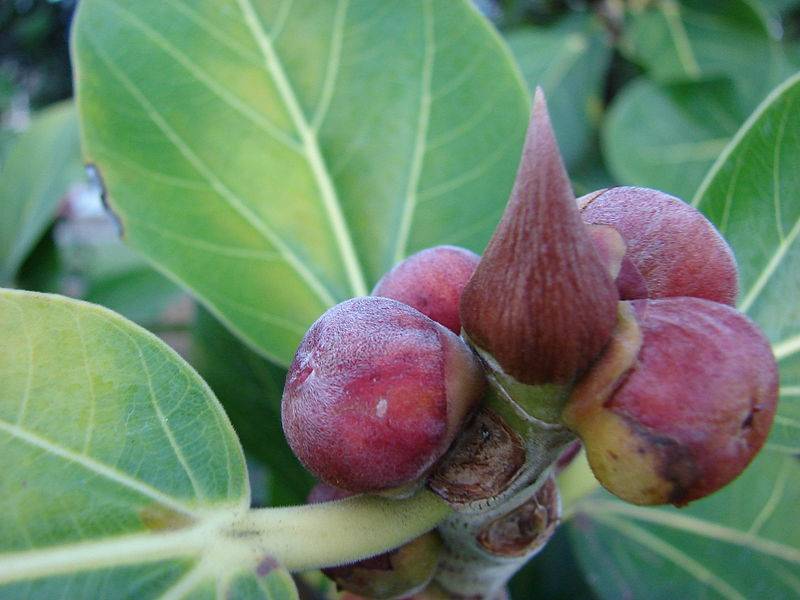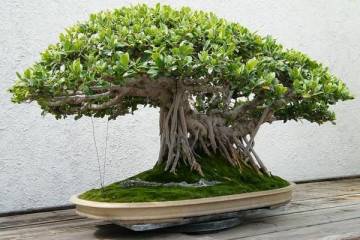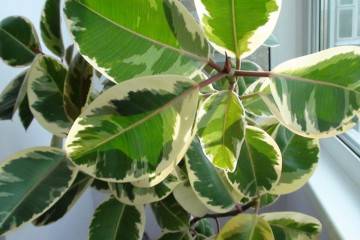Ficus Moklame - home care
Content:
This plant has a beautiful decorative appearance and unpretentious care. If you follow the necessary requirements, then the ficus Moklame will take root and will delight the owners with its appearance. However, it must be borne in mind that when grown at home, flowers do not appear on it.
What does Ficus Moklame look like, which family does it belong to
Ficus belongs to the mulberry family. In the wild, it can be seen in tropical or subtropical areas. This plant is tall - trees can grow up to 25 meters. However, when grown in captivity, the growth of the Moklame ficus does not exceed one and a half meters.
Unlike other varieties of ficus, Moklame has oval leaves with a rounded end, and is also characterized by a large number of aerial roots.
The bark of the plant is brown-gray in color. The leaf plates are bright green.
The fruits are no more than one centimeter in size.
Common varieties
Ficus Moklame has few varieties. Here are the most famous ones:
- Variegated variety. This ficus is distinguished by its beautiful colors and the fact that it loves bright lighting.
- This variety is called Ginseng. This word is also called ginseng. This variety received such a name because it has powerful and broad roots.
In Ginseng, when growing at home, they try to externally highlight the roots, which, along with the crown, have a decorative value.
Healing properties
This plant is known for its medicinal properties:
- In the presence of sciatica or mastopathy, it can significantly improve the patient's condition.
- Allows you to clean the air from benzene or phenol vapors.
- Has a disinfectant effect on the air.
- Helps to improve the psychological state: helps to reduce aggression, removes irritability and anger from those who are next to him.
This type of ficus has gained popularity due to its decorative properties and the ability to positively influence human health.
Briefly about the history of appearance
Ficus microcarp Mokleim has been growing in the wild for centuries. Gradually, it began to be grown in homes and gardens. In order for him to settle down at home, he needs to provide suitable conditions.
Features of caring for a flower at home
When growing ficus Moklame, you must follow the rules of care. Only in this case can we count on its full development.
Temperature
The most comfortable temperature for ficus Moklame is 25-30 degrees. In winter, the plant needs 15-20 degrees. It is important to prevent hypothermia, therefore it is not recommended to put a pot of ficus on the floor in winter.
Lighting
For this plant, for normal development, according to the description, it is enough to provide moderate lighting. In winter, the lack of light is compensated by using fluorescent lamps. Daylight hours for ficus Moklame should not last less than 8 hours.
Watering
For irrigation, water is used, which has been defended for 12 hours. The time for this procedure comes when the top layer of the soil dries up. In winter, do not water more than once every two weeks.
Spraying
Leaves dry quickly and need moisture. To help them, you need to spray regularly.
Humidity
For ficus Moklame, when taking care at home, it is recommended that the humidity be in the range of 50-70%. In hot summer weather, the plant will benefit from additional spraying.
Priming
For ficus, soil with low acidity is suitable. The primer can be purchased at a specialist store.
Top dressing
In the spring, special fertilizers for ficuses are used as fertilizers. In the summer months, nitrogenous fertilizers will be helpful. There is no need to feed the ficus during the autumn and winter seasons.
Features of care in winter, dormant period
In winter, the frequency of watering is limited. At this time, you need to provide a temperature of 10-16 degrees. It is important to avoid hypothermia of the plant during this time.
When and how it blooms
Ficuses usually bloom in the wild. At home, this almost never happens.
Types of flowers
In order for flowers to develop, they need pollination, which is almost impossible to provide at home.
Flower shapes
Ficus flowers are small in size. They can be pale pink, white, light blue or beige. If flowers appear, it usually happens in large numbers. They are rounded. The petals fold in a ball, leaving an opening for insects to pollinate the plants.
Changes in care during flowering
In order to ensure the possibility of flowering when growing in an apartment, it is necessary for the plant to create ideal conditions and not allow the slightest deviation from them.
Pruning
Pruning is done primarily to remove dried or old leaves or shoots. The time for this procedure comes in the spring. This is due to the need for new branches to have time to develop and get stronger before the onset of winter.
Pruning is also done so that the crown has a beautiful shape, which is created by trimming the shoots and leaves as needed.
How ficus Moklame reproduces
Cutting is considered the most effective method. Next, we will talk about the most popular ways to reproduce ficus.
Germinating seeds
Before germinating seeds, they must be treated with a growth stimulant. Then plant in a container with moist and loose soil. The seeds are kept warm and watered regularly. When they sprout, they can be planted in a pot.
Rooting cuttings
As cuttings, shoots 10-15 cm long are used. It is necessary that the cut is held at an oblique angle. The juice must be washed off, and the lower branches and leaves must be removed.
Cuttings are placed in water at room temperature and placed in a warm place. It is necessary to add a disinfectant (activated carbon tablet).
After two weeks, the first roots are formed. The plant is planted in a mixture of perlite, sand and peat. When the sprout takes root, remove all the leaves except the top two. Now it can be planted in a pot.
Air layering
On the stems, cuts are made with a length of 3 cm on both sides. Wrap with moss and tie. The moss is watered regularly. When roots are formed, the branch is cut below the root and planted in a pot.
Transfer
The need for a transplant arises when the root system has developed so much that it ceases to fit in a pot. It is made during the spring or summer season.
Transplanting too often is not recommended.
The new pot should be selected so that the root system grows comfortably there. Usually, a pot is used, the size of which is 5 cm larger than that of the previous one.
Possible growing problems and diseases
If you break the rules of care, then the plant will have problems. The following is a detailed description of the most popular of them.
Drops buds and leaves
Falling leaves indicate a violation of the rules of care: errors during watering, the presence of temperature changes. In order to remedy the situation, you need to take care of the plant correctly.
Leaves turn pale
In this case, the cause is excessive moisture, which has led to rotting of the roots. It is necessary to remove damaged areas and provide the plant with good drainage.
The tips of the leaves dry
Drying occurs if the Moklame ficus is exposed to bright sunlight. Excessive lighting will damage the plant. To return the leaves to their previous appearance, it is necessary to close the ficus from direct sunlight.
The lower leaves fall
This is possible when the plant is rearranged. A new place can shock the ficus, as a result of which it can lose some of the leaves.
Pests
Ficus Mokleim can suffer from spider mites, aphids, mealybugs or scale insects. To combat them, you need to rinse the plant with lukewarm water and spray with an insecticide.
Signs and superstitions
This plant not only has health benefits, but also symbolizes wisdom, love and fertility. There are no special signs associated with it. Unless there is an opinion that he brings harmony and comfort to the house. However, this can be said about almost any house plant.
Ficus Moklame does not require complex care. It has decorative qualities and can be combined with almost any decor in the house. With careful observance of the rules of cultivation, it will delight the owners for many years.




















